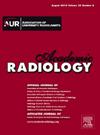预测胰体和/或胰尾腺癌远端胰腺切除术后胰瘘的基线体成分和三维细胞外体积分数。
IF 3.8
2区 医学
Q1 RADIOLOGY, NUCLEAR MEDICINE & MEDICAL IMAGING
引用次数: 0
摘要
理由和目标:临床相关的术后胰瘘(CR-POPF)是接受远端胰腺切除术(DP)的体部和/或尾部胰腺导管腺癌(PDAC)的一种威胁性并发症,术前难以预测。我们旨在确定基于 CT 的基线身体成分分析和细胞外体积(ECV)图在预测术前 CR-POPF 风险中的作用:共329例可切除的PDAC患者接受了多相位对比增强CT检查。计算身体成分指标,并通过多相 CT 图像生成 ECV 图。比较了CR-POPF和非CR-POPF患者在临床变量和定量参数上的差异。分析了ECV分数与胰腺纤维化分期之间的相关性。通过多变量逻辑回归筛选出独立的预测因素,并建立了CR-POPF的预测模型。结果:329名患者中,19.76%(65/329)发展为CR-POPF。白蛋白、胰腺质地和术中失血用于建立临床模型,AUC 为 0.764。选择 ECV 分数和总肌肉比率 (TMR) 建立放射学模型,AUC 为 0.872。整合了白蛋白、ECV 分数和 TMR 的组合提名图能显著提高辨别能力,其 AUC 为 0.924(Delong 检验,均为 p 结论:白蛋白、ECV 分数和 TMR 的组合提名图能显著提高辨别能力,其 AUC 为 0.924:基于CT的体成分分析和ECV在预测DP后体表和/或尾部PDAC的CR-POPF方面表现出巨大的潜力。组合提名图能进一步提高预测性能。本文章由计算机程序翻译,如有差异,请以英文原文为准。
Baseline Body Composition and 3D-Extracellular Volume Fraction for Predicting Pancreatic Fistula after Distal Pancreatectomy in Pancreatic Body and/or Tail Adenocarcinoma
Rationale and Objectives
Clinically relevant postoperative pancreatic fistula (CR-POPF) is a threatening complication in body and/or tail pancreatic ductal adenocarcinoma (PDAC) receiving distal pancreatectomy (DP) and is difficult to predict preoperatively. We aimed to identify the role of baseline CT-based body composition analysis and extracellular volume (ECV) map in predicting the risk of CR-POPF preoperatively.
Materials and Methods
A total of 329 resectable PDAC patients were enrolled and underwent multiphasic contrast-enhanced CT. Body composition indicators were calculated, and ECV maps were generated through multiphasic CT images. The differences in clinical variables and quantitative parameters between CR-POPF and non-CR-POPF patients were compared. Correlations between ECV fraction and pancreatic fibrosis stage were analyzed. Multivariate logistic regression was performed to screen the independent predictors and develop prediction models for CR-POPF. Receiver operating characteristic curve was utilized to evaluate the predictive performance.
Results
Among 329 patients, 19.76% (65/329) developed CR-POPF. Albumin, pancreatic texture, and intraoperative blood loss were used to build the clinical model with an AUC of 0.764. ECV fraction and total muscle ratio (TMR) were chosen to build the radiological model with an AUC of 0.872. A combined nomogram integrated with albumin, ECV fraction, and TMR could significantly improve the discrimination ability to an AUC of 0.924 (Delong test, all p < 0.05). The ECV fraction showed high positive correlation with histological fibrosis grade (Spearman ρ = 0.81).
Conclusion
CT-based body composition analysis and ECV exhibited great potential for predicting CR-POPF in body and/or tail PDAC after DP. The combined nomogram could further improve the predictive performance.
求助全文
通过发布文献求助,成功后即可免费获取论文全文。
去求助
来源期刊

Academic Radiology
医学-核医学
CiteScore
7.60
自引率
10.40%
发文量
432
审稿时长
18 days
期刊介绍:
Academic Radiology publishes original reports of clinical and laboratory investigations in diagnostic imaging, the diagnostic use of radioactive isotopes, computed tomography, positron emission tomography, magnetic resonance imaging, ultrasound, digital subtraction angiography, image-guided interventions and related techniques. It also includes brief technical reports describing original observations, techniques, and instrumental developments; state-of-the-art reports on clinical issues, new technology and other topics of current medical importance; meta-analyses; scientific studies and opinions on radiologic education; and letters to the Editor.
 求助内容:
求助内容: 应助结果提醒方式:
应助结果提醒方式:


